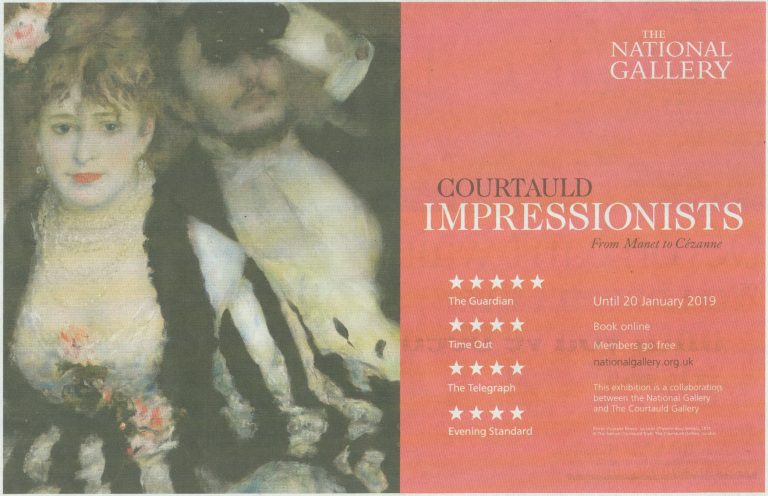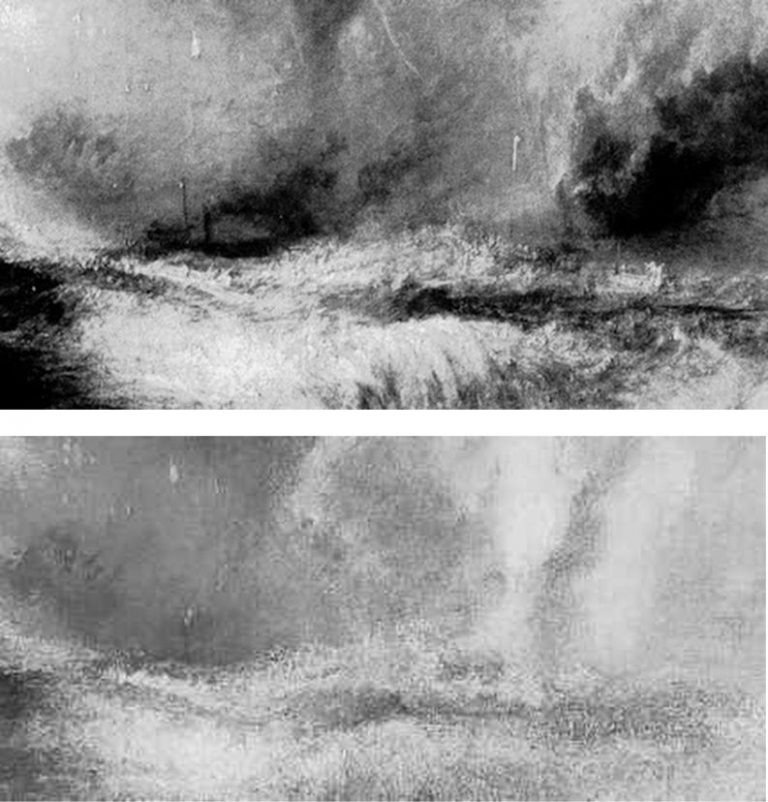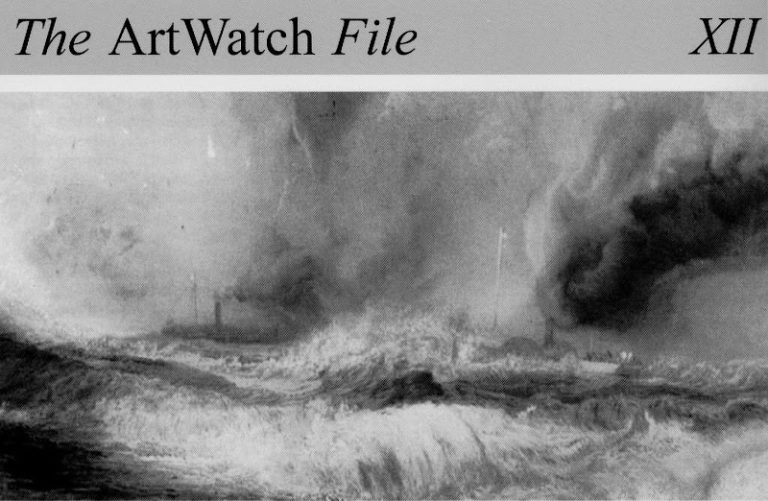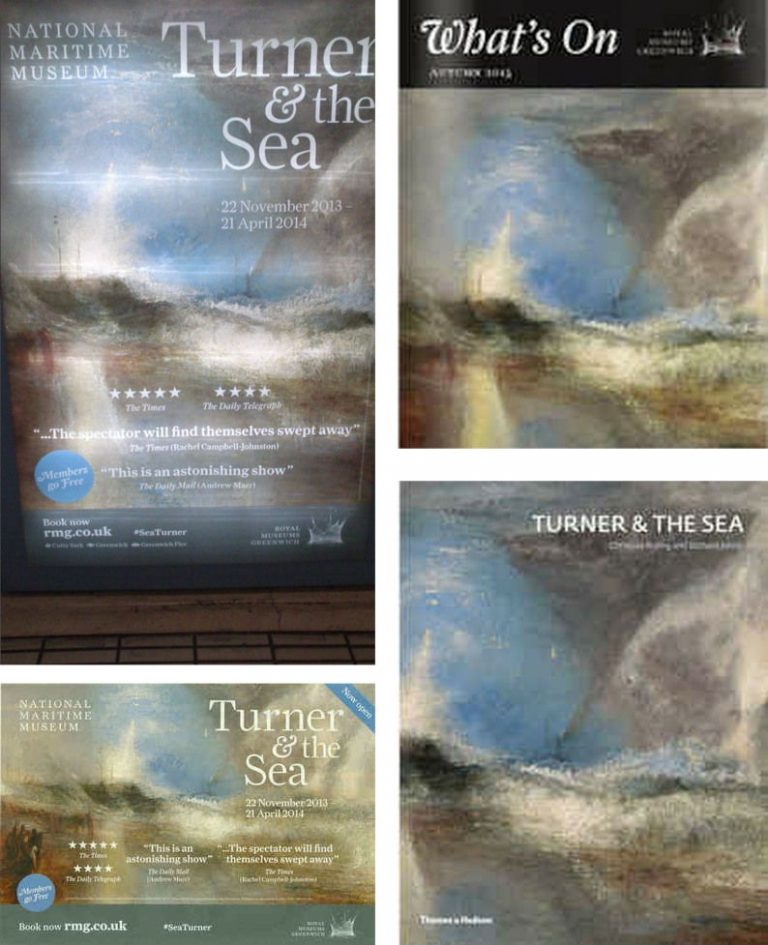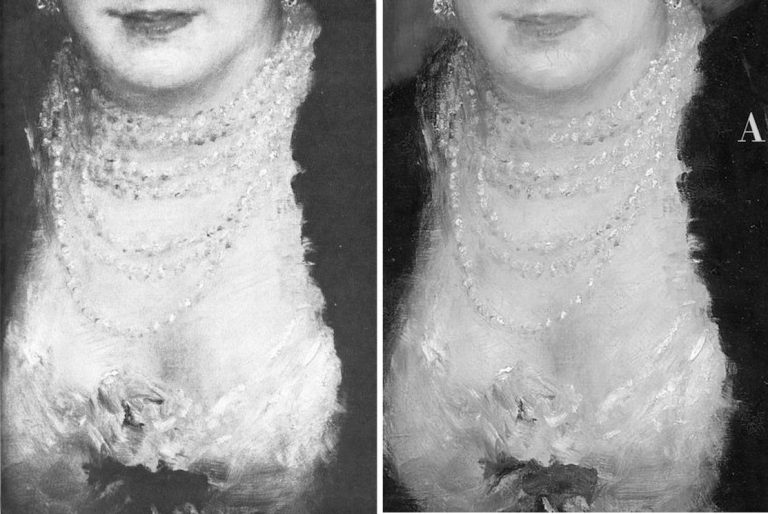Hyping museum-restoration wrecks
Today museums seem as likely as not to be closed for “re-development”. Even small “time-capsule” artists or collectors home/museums, like Leighton’s, are fair game. Closures present loan opportunities and the National Gallery has snaffled some Courtauld Gallery Impressionist plums.
The hyped plum-of-plums in the National Gallery’s four star (- the Guardian gives five) Courtauld Impressionists from Manet to Cezanne blockbuster is the Courtauld Gallery’s Renoir, La Loge (as above). Today, bigging-up such restoration-damaged masterpieces seems to constitute museum world chic, as we discussed in March 2014 in “From Veronese to Turner, Celebrating Restoration-Wrecked Pictures”. At that date the most blatant hype was bestowed on a borrowed Turner seascape in which one of the picture’s two steamboats had been scrubbed away in the restoration wash, as seen below:
The above detailed comparison of Turner’s Rockets and Blue Lights (Close at Hand) to Warn Steamboats of Shoal Water shows (top) a 19th century photograph – by courtesy of Christie’s – and the painting (above) as flaunted in the National Maritime Museum’s 2013-14 Turner and the Sea exhibition. Sinking a boat and turning its belching black coal smoke into a waterspout might be thought as clinching a demonstration of restoration injury as could ever be encountered. However, that early photograph had been preceded by a large chromolithographic copy (see below) that had even better recorded Turner’s original second boat and distressed crew, and therefore gives a truer indication of the magnitude of artistic injury.
Some art critics alert to words might have noticed that the picture was described by Turner to contain “steamboats” – not a single boat – but, if so, none paid heed. Seemingly taking their collective lead from a Tate press release to an earlier Turner exhibition that had proclaimed this wreck-of-wrecks to be “One of the stars of the show”, it having “recently undergone major conservation”, the critics gushed in unison with their four and five-star reviews and the Maritime Museum was able to flood the world with posters and reviews (as below) celebrating this most-wrecked Turner seascape:
“…this show contains some of the most extraordinary passages of painting ever applied to canvas. Its centrepiece, the recently restored Rockets and Blue Lights… is an unbelievable vision of swirling blue, orange and white light thrusting through fog” [Daily Telegraph]; “Easily the most stunning picture in the show is Rockets and Blue Lights…The canvas has been given a restorative makeover…Turner’s brushwork is revealed in all its glory” [the Independent]; “Most splendid…is the dramatic and recently restored Rockets and Blue Lights, a picture so spectacular, that like the shadowy group of figures on the foreshore, you can only stare and wonder” [the Times].
We sometimes wonder.
That was then. Today the much hyped wreck-of-the-moment in the National Gallery/Courtauld Impressionist bonanza is none other than the latter’s own “iconic” Renoir, La Loge – as below:
We had examined this specimen in an August 2012 post: “Reviews: Taking Renoir, Sterling and Francine Clark to the Cleaners”.
In the comparison above we showed a detail (left) of the painting as seen as seen in 1921 in Georges Rivière’s Renoir et Ses Amis next to the painting (right) as in the Courtauld catalogue of 2008 at Fig. 5. The two reproductions were of very unequal quality but, even so, the permitted comparisons were alarming: both ears are now fully exposed, where before only one had been; the background had been darker; the eyebrows had been less symmetrical; the flower at the bosom had been more distinct, and so on…
In the comparison above, the reproductions were better matched. That on the left came from a plate in Anthea Callen’s 1978 book Renoir; that on the right from the Courtauld’s 2008 catalogue. Here, in the earlier state, we see firmer modelling in the jaw; stronger drawing and modelling in the mouth; a stronger flower and bow below; and, again, a more subdued background. What might account for these differences? Our money would be on a “restoration” ahead of the 2008 exhibition – perhaps one of those restorations that are presented as discovery-yielding technical research… In any event, we can presumably all see that something happened in the thirty years between 1978 and 2008 to cause the paint on the chin to start to cracking – as can better be seen in the comparison below:
In our 2012 post we had shown a similar outbreak of cracking that attended the National Gallery’s restoration of Renoir’s “The Umbrellas”, as shown in details below. We observed that if the heavily cracked appearance of Renoir’s “La Loge” might be thought a poor advertisement for the Courtauld Institute’s own conservation training programme, what confidence should the emergence of massive cracking in the cleaned face of a principal figure in a major Renoir give in the National Gallery ’s cleaning policies?
With the National Gallery restoration there can be no casting of doubt on the photographic records: these images – above and below – are taken directly from the gallery’s own excellent photo-records of the painting that were made immediately before and immediately after the restoration in question – as photo-testimony, this is as good as it gets.
What conclusion can be drawn? We see above, as below, sudden outbreaks of cracking in two different and previously well-preserved Renoir portraits held in two prestigious London galleries. If these injuries are not consequences of restoration or conservation “treatments”, how might they have arisen? As things stand, the evidence of our eyes can only tell us that pictures are not safe in London museums. Must we further conclude that the museum staffs themselves simply fail to notice injuries and are therefore not up to the job? Or, that they feel so institutionally-protected as to be under no obligation to give account for injuries to the works they hold in trust for the nation? There has to be some explanation – and it is now, perhaps, time for it to be given?
Michael Daley, 31 October 2018

